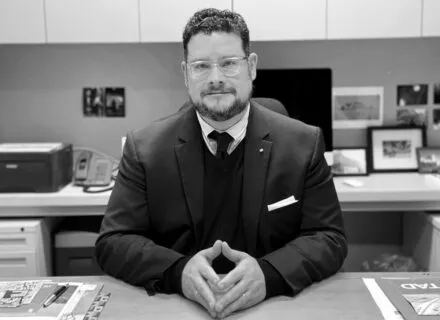
Q&A with Francisco Rodríguez-Suárez, Director of the Illinois School of Architecture
Why Illinois? What inspired you to pursue the role of director at the Illinois School of Architecture?
I was enamored both by its remarkable history and its incredible potential. I was also intrigued by the possibility of designing a unifying paradigm between memory and desire as we move forward to draw the next few lines in the collective canvas of our imagination. During the past decade, I have served as both the Dean of a School of Architecture and the President of the Association of Collegiate Schools of Architecture. My own research has gravitated around a series of symposia, interviews, and visits of over 100 architecture schools in five continents resulting in a book titled, Chronologies of an Architectural Pedagogy.
What are your top priorities as director?
I look forward to leading the school into the twenty-first century as an epicenter of design, research, and innovation aimed at the challenges posed by the new millennium. The School is part of a major research university that was just ranked by Forbes as one of the Top 50 in the World, boasting a stellar academic community of students and professors that can compete with the very best both nationally and internationally. On the other hand, being part of a large major research public university also limits the possibility of moving at the speed of innovation and changes posed by the new millennium. We have to design a way to remain flexible and relevant, or we will be condemned to the role of observers.
How do you hope to positively impact students and faculty in your role as director in the next 5 years?
I am committed to repositioning the School at the forefront of the academic and professional discourse, expanding our international footprint and relevance. I would also like to find effective avenues to communicate what is ostensibly the beautiful and exciting story of the Illinois School of Architecture.
How do you think architecture education can best keep up with changes in the profession as we look to the future?
My ideas about architectural education tend to stem from the perspective of a practitioner; therefore, I will inevitably extend any disciplinary reflections into the realm of practice, and the search within my own experience of a unifying paradigm between theory and practice.
It is not the only duality I will address as a Director. In this academic institution, as in most, we offer degrees that revolve strictly around the arts and others around the sciences, but as architects within this millenarian tradition called university, or universe of knowledge, I believe we are privileged to engage a discipline that is as much about one, as it is about the other: architecture – ar or archos and techne. Granted, in some places the pendulum may be somewhat inclined to the humanities and in others, such as our own experience, it may gravitate to a more technological pursuit; nevertheless, architecture, as a unique and remarkable discipline, inhabits a special place that is rather eloquent in sometimes contradictory worlds.
Because of the fact that I originally arrived in academia as a practicing architect teaching design, I gravitated to inquire and acquaint myself on the origins of the university: Plato and the Academy, Aristotle and the Lyceum, Cassidorius and the liberal arts curriculum of the trivium and the quadrivium in a monastery in his hometown of Vivarium, the predecessor of the monastic schools that eventually evolved into the first universities in Bologna, Paris, and Salamanca. A thousand years later, we are still speculating about our place within this complex, and yes, sometimes contradictory, interlocking scaffolding of degrees, credits, requirements, and accreditations that we sometimes take for granted.
Our schools have been the epicenters of innovation and change, and yet, innovation, on this day and age, occurs faster than our own institutional ability to digest it in our academic circles, which are mostly well-meaning but rather slow and bureaucratic. Change is no longer taking place because, but in spite of our best intentions, so we need to sit down as an academic community and have a thoughtful conversation about our continued relevance as a discipline and about the shared and diverse platforms that our students will inherit from our generation, hopefully falling in love with the process the same way we did sometime during the waning years of the previous century.
The School of Architecture recently brought in some new faculty members. How do they play a role in your vision for the future of the School?
We have four new faculty positions joining the School: the Gertrude Kerbis endowed professorship in the area of structures, materials, and technological innovation, a digital fabrication tenure-track position, a health and well-being three-year position, and an associate director for academic affairs. These, along with two additional new faculty hires, will transform the immediate future of our academic community. These remarkable academics and practitioners from four different countries all share common denominators of talent, innovation and experience, and I am ecstatic about the prospects – especially as we move to occupy a more prominent international platform within our discipline.
